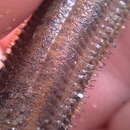Comprehensive Description
provided by Smithsonian Contributions to Zoology
Pelogenia antipoda Schmarda, 1861
Pelogenia antipoda Schmarda, 1861:160, pl. 37: figs. 320–322, text-figs. a,b.
Psammolyce antipoda.—Ehlers, 1905:13.—Augener, 1927b:340; Not 1927a: 124 [= Pelogenia malayana].—Not Fauvel, 1917:186, pl. 4: figs. 12, 13 [= Pelogenia popeae. n. sp.].—Not Pope, 1943:248 [= P. popeae, n. sp.].—Not Amoureau, Rullier, and Fishelson, 1978:71 [= Pelogenia sp.].
MATERIAL EXAMINED.—SOUTH PACIFIC OCEAN: New Zealand: East coast, in deep mud, Schmarda, collector, syntype (NMV 2182). Tauranga, Thilenius, collector, 2 specimens (ZMHUB 6645; ZMH 10393, identified by Augener, 1927b). East Kau Point, Wellington Harbor, coarse sand and silt, anchor dredge, 23 Feb 1971, G.P. Read, collector, 2 specimens (USNM 60188).
TYPE MATERIAL.—Syntype (NMV 2182) complete specimen, about 85 mm long and 9 mm wide, with setae, more than 180 segments.
DESCRIPTION.—Specimen from Tauranga (ZMH 10393) 150 mm long and 12 mm wide, with setae, 293 segments. Figured specimen from Wellington Harbor (USNM 60188) incomplete, 49 mm long and 12 mm wide, 55 segments. Dorsum thickly papillate (furry) and thickly covered with sand grains on posterior to (Schmarda, 1861, pl. 37: fig. 320); ventrum thickly covered with long cylindrical papillae, especially along midventral groove and on lower lip between segments II-VI (Figure 21B). First 3 pairs of elytra covering prostomium and dorsum, following elytra confined to lateral sides of body. Elytra thick, tough, opaque, 1st pair oval, with short oval and clavate papillae on borders and surfaces, with scattered sand grains (Figure 23A); 2nd pair subreniform, with longer papillae on lateral borders (Figure 23B); elytra beginning with 5th pair with prominent medial processes covered with numerous clavate papillae, some flattened distally, with concentration of adherent sand grains; with long filiform papillae along lateral and posterior borders (Figure 23C,D).
Prostomium and tentaculophores withdrawn in anterior segments (II-IV); prostomium elongate-oval, widest basally; ceratophore of median antenna long, thick, bulbous basally, style longer than ceratophore, with tapered tip; without lateral ctenidia; 2 pairs of rather large eyes, ventral pair slightly larger than dorsal pair; tentaculophores each with single aciculum, long dorsal and shorter ventral tentacular cirri on outer side, and 3 bundles of capillary notosetae and tentacular sheath on inner side; palps stout, tapered, about 3 times longer than ceratophore of median antenna, emerging ventral and lateral to tentaculophores, with short inner palpal sheaths continuous with inner tentacular sheaths; lateral antennae small, tapered, on dorsal sides of tentaculophores (Figure 21A–C).
Segment II with first pair of large elytrophores, without lateral branchiae; ventral buccal cirri extending beyond tips of neuropodia; lower lip of ventral mouth with long papillae (Figure 21B,D); compound neurosetae slender, stems with long spinous regions, blades long, tapering to slightly curved to strongly curled tips (Figure 2E). Pharynx (cut open) with 11 pairs of border papillae and 2 pairs of dark brown, hooked jaws. Segment III with long dorsal cirri, cirrophores continuous with bulbous dorsal tubercles and extending to about tips of notopodia with small branchiae on lower sides, styles about equal in length to cirrophores; cirrophores of ventral cirri with 4 long papillae on lower sides, styles extending to tips of neurosetae (Figure 21F); neurosetae similar to those of segment II, stems with shorter spinous regions, and blades with or without slender secondary tooth (Figure 21G). Segment IV with neurosetae stouter than those on anterior segments, similar to those on following segments; stems of upper neurosetae with 7–14 spinous rows, blades short, with small secondary tooth; stems of middle ones with 0–3 spinous rows and blades with entire or bifid tips; stems of lower ones more slender, with 3–5 spinous rows and blades all with bifid tips (Figure 22A).
Biramous parapodia with notopodia short, subconical, with thick, fleshy subdistal flanges encircling notosetae; without distinct ctenidia between notopodia and branchiae and dorsal tubercles or elytrophores; dorsal tubercles with conical glandular lobes on anterior and posterior sides near attachments of branchiae; neuropodia long, subconical, paplllate distally, with usual 3 subdistal bracts with long papillae; cirrophores of ventral cirri with 3–5 papillae on lower sides, styles extending to tips of lower sides of neuropodia, with basal knobs; additional papillae on ventral sides of neuropodia medial to ventral cirri and on dorsal surfaces above dorsal tubercles and elytrophores (Figure 22B,C). Notosetae numerous, spinous, capillary, extending dorsally, anteriorly, and posteroventrally beyond tips of ventral cirri (Figure 22B,C). Neurosetae dark amber-colored compound falcigers; upper group (4) within dorso-anterior bracts, stems with 2–3 spinous rows, blades rather long, tips slightly hooked, with slight indication of secondary tooth; middle ones (11) within postacicular bracts, stouter, with 0–1 spinous rows, blades short, slightly hooked, with tips entire or bifid; lower ones (7), within ventro-anterior bracts, more slender, stems with 1–3 spinous rows, blades rather long, with tips hooked, entire or bifid (Figure 22D; Schmarda, 1861, text-figs. a,b).
DISTRIBUTION.—South Pacific Ocean: New Zealand; low intertidal.
- bibliographic citation
- Pettibone, Marian H. 1997. "Revision of the sigalionid species (Polychaeta) referred to Psammolyce Kinberg, 1856, Pelogenia Schmarda, 1861, and belonging to the Subfamily Pelogeniinae Chamberlin, 1919." Smithsonian Contributions to Zoology. 1-89. https://doi.org/10.5479/si.00810282.581

